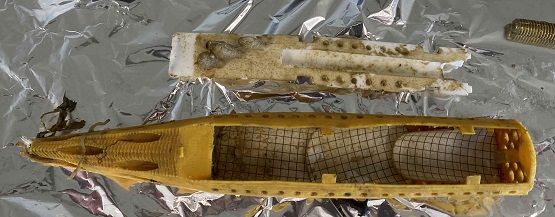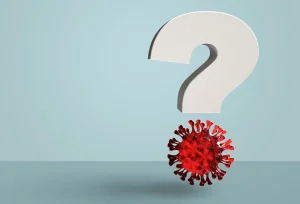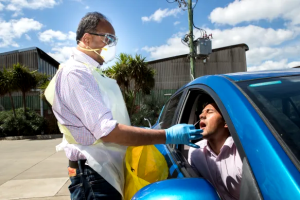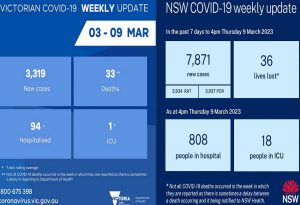- Monash University researchers have developed the ‘Torpedo Passive Sampler’ – a cheap, accurate and simple testing device to detect SARS-CoV-2 in wastewater.
- Current automatic sampling methods are expensive to operate and cannot identify regions small enough for targeted health actions…this new device can.
- As the intellectual property is open, the 3D printing files can be
shared rapidly with governments and health professionals across the world. More
than 2500 have been issued globally to date.
A simple, cost-effective and portable device, shaped like a torpedo, has been successful in detecting SARS-CoV-2 in wastewater in Victoria – opening avenues for a global rollout as the virus continues to ravage major cities.
Researchers at Monash University’s Department of Civil Engineering, in partnership with a consortium of universities and industry locally and internationally, have provided the first evidence that passive samplers can be used to detect SARS-CoV-2 in wastewater at three different scales – an individual lot, suburb and city.
Dubbed the ‘Torpedo Passive Sampler’ and the ‘sewage submarine’, it was constructed using cotton buds, medical gauze swabs and lab grade electronegative membranes. They were encased in a narrow 3D printed shell.
The passive samplers were placed across eight study sites in Victoria ranging from systems that collected the wastewater of 260 residents and staff near an aged care facility, to Melbourne’s largest sewage treatment plant that pools wastewater from more than two million residents.
Seven of the eight sites were in metropolitan Melbourne, with the other in Colac. All sites were chosen due to having known cases of COVID-19 during the second wave of infections.
Analysis showed success in detecting SARS-CoV-2 using passive sampling. The research also demonstrated that when the daily average SARS-CoV-2 concentration in wastewater exceeds 1 copy per mL, at least one of the passive samplers deployed at the same site on the same day was also positive.
In great news for Australian state and territory governments, and countries across the world, the intellectual property for the ‘Torpedo Passive Sampler’ is open and 3D printing files are able to be shared for immediate use.
In just five months, more than 2500 ‘Torpedo Passive Samplers’ have been exported and used in all states and territories of Australia, New Zealand, Canada, the Netherlands, and are soon to arrive in the USA and Indonesia.
Passive sampling involves the deployment of a device in a waterbody for a known time, allowing for pollutants in the water to interact with the device.
Lead author, Associate Professor David McCarthy, from Monash University said passive sampling presents a cheap, safe and easy alternative to traditional wastewater sampling.
“These results indicate that cotton buds, electronegative membranes and gauzes can be used as passive samplers of SARS-CoV-2 in human wastewater. This is the first proof of concept that one or more of these passive samplers could be prime candidates for further optimisation to monitor for SARS-CoV-2 and for other problematic viruses in the future,” Associate Professor McCarthy said.
“The process of sewerage monitoring is really difficult, especially in countries like Australia where very few people are infected with COVID-19. This means we’re trying to find maybe one or two infected stool samples in a pool of tens of thousands of healthy samples.
“This is why efficient and portable methods are needed. The portability and size of the ‘torpedo’ means we can be more targeted in testing wastewater and narrow down the areas where people are likely to be shedding the virus, such as a suburb or aged care facility.
“Above all, the ‘torpedo’ is cheap – roughly $20 each compared to more than $5000 for each automatic sampler – easy to use, and provide more consistent results than other sampling methods.”
The idea for developing passive sampling technology for monitoring the COVID-19 virus in wastewater came from Melbourne Water’s Dr Nicholas Crosbie, who in turn was inspired by the classical work of Dr Brendan Moore (investor of the so-called ‘Moore Swab’).
The design behind the ‘Torpedo Passive Sampler’ is simple. Researchers head out to a site, throw the ‘torpedo’ into the water and let it sit for up to four days.
During this time, the materials inside the ‘torpedo’ absorb traces of the SARS-CoV-2 virus as it passes – almost like a fishing net.
The samples are then brought back to the lab for analysis. Early evidence indicates that the amount of virus that is ‘caught’ could be linked to the number of people infected in the catchment.
Wastewater sampling has been adopted across many Australian cities and towns to locate, track and trace evidence of SARS-CoV-2 in residential communities.
People infected with COVID-19 will generally shed or excrete the SARS-CoV-2 virus through faeces, via coughing or sneezing. These excretions end up in wastewater drains when people flush their toilets or have a shower.
There is evidence that this shedding/excretion begins early in the infection stage, sometimes even before an individual experiences any flu-like symptoms.
“This discovery is exciting and ground-breaking as it can fundamentally change the way we detect critical virus spread in our community, and can help with targeted health care actions. Plus, we can also offer these solutions to communities globally that are in desperate need of cheap and easy to use methods to help curb the spread of this virus,” Associate Professor McCarthy said.
Associate Professor David McCarthy from Monash University led this project. Research partners include Victoria Government’s Department of Health, Melbourne Water Corporation, Water Research Australia, the ColoSSoS program, The University of Melbourne, South East Water, Victorian Infectious Diseases Reference Laboratory, Department of Water Management at TU Delft (The Netherlands), Partners4UrbanWater (The Netherlands), ALS Hydrographics and Barwon Water.
To download a copy of the research, please visit http://dx.doi.org/10.13140/RG.2.2.24138.39367
Source: Medianet












